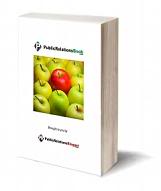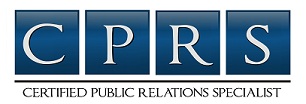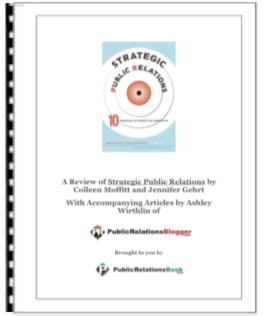________________________________________________________________________
 Public relations (PR) is the practice of managing the flow of information between an organization and its publics. Public relations gains an organization or individual exposure to their audiences using topics of public interest and news items that do not require direct payment. Because public relations places exposure in credible third-party outlets, it offers a third-party legitimacy that advertising does not have. Common activities include speaking at conferences, working with the press, and employee communication.
Public relations (PR) is the practice of managing the flow of information between an organization and its publics. Public relations gains an organization or individual exposure to their audiences using topics of public interest and news items that do not require direct payment. Because public relations places exposure in credible third-party outlets, it offers a third-party legitimacy that advertising does not have. Common activities include speaking at conferences, working with the press, and employee communication.
PR can be used to build rapport with employees, customers, investors, voters, or the general public. Almost any organization that has a stake in how it is portrayed in the public arena employs some level of public relations. A number of specialties exist within the field of public relations, such as Analyst Relations, Media Relations, Investor Relations or Labor Relations.
Definition:
The Public Relations Society of America (PRSA) claimed: "Public relations helps an organization and its publics adapt mutually to each other." According to the PRSA, the essential functions of public relations include research, planning, communications dialogue and evaluation.
Edward Louis Bernays, who is considered the founding father of modern public relations along with Ivy Lee, in the early 1900s defined public relations as a management function which tabulates public attitudes, defines the policies, procedures and interests of an organization. . . followed by executing a program of action to earn public understanding and acceptance" (see history of public relations).
Today, "Public Relations is a set of management, supervisory, and technical functions that foster an organization's ability to strategically listen to, appreciate, and respond to those persons whose mutually beneficial relationships with the organization are necessary if it is to achieve its missions and values." Essentially it is a management function that focuses on two-way communication and fostering of mutually beneficial relationships between an organization and its publics.
Building and managing relationships with those who influence an organization or individual's audiences has a central role in public relations.
The industry today:
Advertising dollars in media products from corporations like News Corp., Dow Jones, and CMP are under rapid decline in favor of direct advertising products offered by search engines and other tools. 11 Traditional media publications are laying off journalists, consolidating beat reporters, shrinking their print editions, and many publications are shutting down entirely.
Blogs have lower over-head costs than traditional media and are often said to provide better news coverage and analysis. Blogs are increasingly sprouting to replace traditional media with a more sustainable low-cost business model and are gaining more of a following.
The advent of social media is the most pre-eminent trend in PR today. It's important to note, while social media is on the rise, traditional media is yet to be taken over by the trend as of January 29, 2009.
Social media releases, search engine optimization, content publishing, and the introduction of podcasts and video are other burgeoning trends.
Public relations and publicity are not synonymous but many PR campaigns include provisions for publicity. Publicity is the spreading of information to gain public awareness for a product, person, service, cause or organization, and can be seen as a result of effective PR planning.
Article Source.
What is Public Relations? | Brief Overview and Definition
________________________________________
 Public relations (PR) is the practice of managing the flow of information between an organization and its publics. Public relations gains an organization or individual exposure to their audiences using topics of public interest and news items that do not require direct payment. Because public relations places exposure in credible third-party outlets, it offers a third-party legitimacy that advertising does not have. Common activities include speaking at conferences, working with the press, and employee communication.
Public relations (PR) is the practice of managing the flow of information between an organization and its publics. Public relations gains an organization or individual exposure to their audiences using topics of public interest and news items that do not require direct payment. Because public relations places exposure in credible third-party outlets, it offers a third-party legitimacy that advertising does not have. Common activities include speaking at conferences, working with the press, and employee communication.PR can be used to build rapport with employees, customers, investors, voters, or the general public. Almost any organization that has a stake in how it is portrayed in the public arena employs some level of public relations. A number of specialties exist within the field of public relations, such as Analyst Relations, Media Relations, Investor Relations or Labor Relations.
Definition:
The Public Relations Society of America (PRSA) claimed: "Public relations helps an organization and its publics adapt mutually to each other." According to the PRSA, the essential functions of public relations include research, planning, communications dialogue and evaluation.
Edward Louis Bernays, who is considered the founding father of modern public relations along with Ivy Lee, in the early 1900s defined public relations as a management function which tabulates public attitudes, defines the policies, procedures and interests of an organization. . . followed by executing a program of action to earn public understanding and acceptance" (see history of public relations).
Today, "Public Relations is a set of management, supervisory, and technical functions that foster an organization's ability to strategically listen to, appreciate, and respond to those persons whose mutually beneficial relationships with the organization are necessary if it is to achieve its missions and values." Essentially it is a management function that focuses on two-way communication and fostering of mutually beneficial relationships between an organization and its publics.
Building and managing relationships with those who influence an organization or individual's audiences has a central role in public relations.
The industry today:
Advertising dollars in media products from corporations like News Corp., Dow Jones, and CMP are under rapid decline in favor of direct advertising products offered by search engines and other tools. 11 Traditional media publications are laying off journalists, consolidating beat reporters, shrinking their print editions, and many publications are shutting down entirely.
Blogs have lower over-head costs than traditional media and are often said to provide better news coverage and analysis. Blogs are increasingly sprouting to replace traditional media with a more sustainable low-cost business model and are gaining more of a following.
The advent of social media is the most pre-eminent trend in PR today. It's important to note, while social media is on the rise, traditional media is yet to be taken over by the trend as of January 29, 2009.
Social media releases, search engine optimization, content publishing, and the introduction of podcasts and video are other burgeoning trends.
Public relations and publicity are not synonymous but many PR campaigns include provisions for publicity. Publicity is the spreading of information to gain public awareness for a product, person, service, cause or organization, and can be seen as a result of effective PR planning.
Article Source.
Subscribe to:
Post Comments (Atom)






Comments (0)
Post a Comment